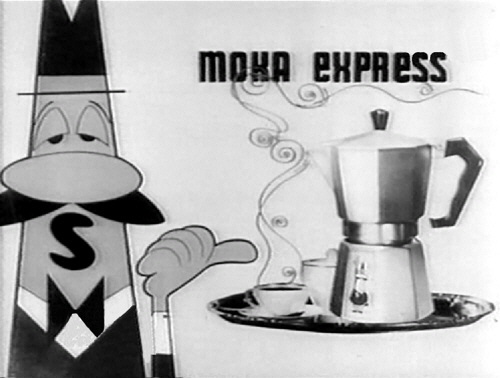As a topic for my Master’s dissertation, I decided to investigate the realm of iconic brands with regards to a specific brand, Bialetti, a world-famous moka pot which I believe is a cultural icon for Italians. I tackled the research question using an integrated approach, which merged Holt’s Cultural Branding Model, Stern’s Deconstructive Strategy and Miller’s Materiality. As the CBM is concerned mainly with the analysis of advertising by examining how advertisements engage with consumers, I used it to determine how Bialetti addressed Italy’s postwar feelings and desires with their commercials from 1958 through 1968. Bialetti’s postwar commercials were structured in such a way as to help men and women live in a world of modernity, which was new to them after twenty years under Mussolini’s dictatorship, and each episode featured the main character, the Omino con i baffi (“Mustachioed Little Man”), teaching the audience how to perform everyday tasks such as DIY plumbing or cooking.
Bialetti set its image in the breadwinner identity myth, using the omino as the symbol for modern men, who wanted to achieve a higher status and were more keen on succeeding in their career than they were on parenting; in this sense the omino is portrayed as a white-collar middle-aged man who is not capable of basic DIY tasks (suggesting he is more intellectual than handy) and is never associated with fatherhood.
Holt’s CBM was integrated with Stern’s Deconstructive Strategy which examines binaries in the advertising messages and argues that they are levers that enhance the persuasiveness of commercials. In Bialetti’s case, I have argued that the funny and cartoon-like voice of the omino is put in opposition with the voice of a woman speaking at the end of the commercial because this juxtaposition enhances the utopian world of Bialetti. This utopian world is the world designed for modern men whose desire was to live a carefree life after almost fifty years of warfare. Furthermore, there exists a Human/Object opposition is Bialetti’s commercials, because the omino is depicted halfway between a moka pot and a man. Leaving his figure undefined enhances the impact of the advertising message on the audience. Finally, I have identified a Male/Female juxtaposition due to the presence of the omino and a look-a-like female counterpart, Aunt Betty. This, I have speculated, is a device that highlights the masculinity of the male character because his female version is portrayed as being more idiotic than him. My integrated approach also included the analysis of Bialetti from a material standpoint, following Miller’s assumptions on materiality. Using Miller’s studies allowed me to see Bialetti as a member of the family, rather than mere object. Thanks to an ethnographic research I conducted amongst Italian families, I have realized that many people share a number of habits. For instance, many informants do not wash their moka pot and many of them place it close to the hob ready for the next brew rather than putting it in the cupboard as they do with other items. Thanks to these shared rules I have witnessed a phenomenon Miller terms humility of things; the ability of possessions to shape and influence us when they are so embedded in our life that we cannot see them anymore. Furthermore, I have argued that a Bialetti moka pot can be considered an objectified companion, an object imbued with person-like qualities. As a matter of fact, it has come to represent a member of the family for the people who use it, keeping it by our side at times of distress, when studying hard for exams and even refer to it using feminine pronouns.
Taking the results of the application of the integrated approach into consideration, I have argued that objects can be analyzed using a triangular model that explains how possessions are imbued with social meaning. I have speculated that objects have an external appearance (shape, color, etc.) and a function and these two elements work in tandem to create the third angle of the triangle, meaning the immaterial condition, because no meaning would exist without a shape or a usage. I have argued that the social meaning of possessions is dynamic and static at the same time. It is static because (in my case) Bialetti will always be associated with iconicity, modernity and good coffee but the brand’s personality evolves and changes, making it dynamic.
This thesis has allowed me to conclude that Bialetti is, indeed, an iconic brand for Italians and it is an indelible part of this nation’s culture. The application of the framework I have employed can be useful for future analysis of iconic brand as well as for structuring an advertising campaign. The integrated approach makes it possible to build the brand image addressing a country’s feelings and anxieties, it makes it possible to understand the levers to use to enhance the effect of commercials and it allows marketers to see how the product becomes part of a family’s life.



No comments:
Post a Comment